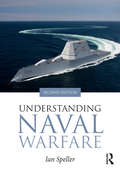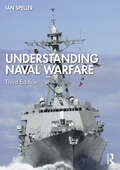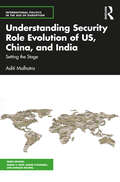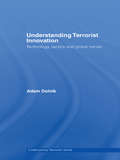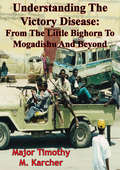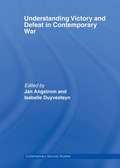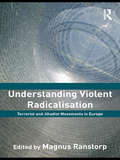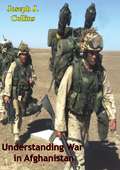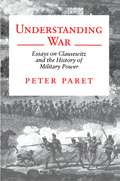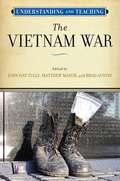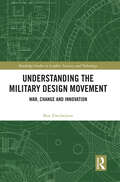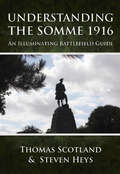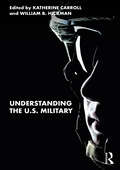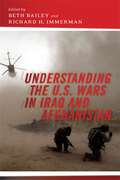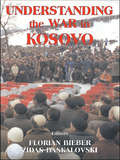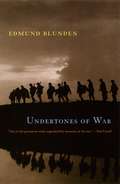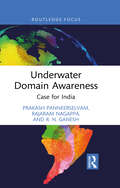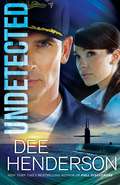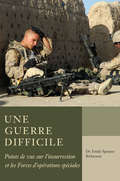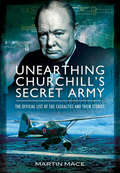- Table View
- List View
Understanding Naval Warfare
by Ian SpellerThis new and updated edition of Understanding Naval Warfare offers the reader an accessible introduction to the study of modern naval warfare, providing a thorough grounding in the vocabulary, concepts, issues, and debates, set within the context of relevant history. Navies operate in an environment that most people do not understand and that many avoid. They are equipped with a bewildering range of ships, craft and other vessels and types of equipment, the purpose of which is often unclear. Writings on naval warfare are usually replete with references to esoteric concepts explained in specialist language than can serve as a barrier to understanding. The objective of this book, therefore, is to cut through the obscure and the arcane to offer a clear, coherent and accessible guide to the key features of naval warfare which will equip the reader with the knowledge and understanding necessary for a sophisticated engagement with the subject. This second edition is divided into two key parts. The first focuses on concepts of naval warfare and introduces readers to the ideas associated with the theory and practice of naval operations. It also includes a new chapter in which the history of the last century of naval warfare is explored in order to illustrate the key concepts. The second part focuses on the conduct of war at sea and on peacetime roles for contemporary navies. This latter section concludes with a chapter that looks ahead to the likely future of naval warfare. This textbook will be essential reading for students of naval warfare, sea power and maritime security, and highly recommended for those studying military history, strategic studies and security studies in general.
Understanding Naval Warfare
by Ian SpellerThis updated new edition of Understanding Naval Warfare offers the reader an accessible introduction to the study of modern naval warfare, providing a thorough grounding in the vocabulary, concepts, issues and debates, set within the context of relevant history. The third edition explains traditional concepts and explores current and emerging ideas concerning the theory and practice of naval warfare, relating these to recent events including Sino-American naval competition and the Russian-Ukraine War. Navies operate in an environment that most people do not understand and that many avoid. They are equipped with a bewildering range of ships, craft and other vessels and types of equipment, the purpose of which is often unclear. Writings on naval warfare are usually replete with references to esoteric concepts explained in specialist language that can serve as a barrier to understanding. This book cuts through the obscure and the arcane to offer a clear, coherent and accessible guide to the key features of naval warfare which will equip the reader with the knowledge and understanding necessary for a sophisticated engagement with the subject. The new edition is divided into two key parts. The first focuses on concepts of naval warfare and introduces readers to the ideas associated with the theory and practice of naval operations and includes a chapter where the history of the last century of naval warfare is explored in order to illustrate the key concepts. The second part focuses on the conduct of war at sea and on peacetime roles for contemporary navies and now includes new material on hybrid warfare and grey zone operations and on joint warfare, multi-domain operations and integrated deterrence within the context of evolving great power rivalry at sea. This textbook will be essential reading for students of naval warfare, sea power and maritime security and is highly recommended for those studying military history, strategic studies and security studies in general.
Understanding Security Role Evolution of US, China, and India: Setting the Stage (International Politics in the Age of Disruption)
by Aditi MalhotraThis book revolves around the altering security roles of three pivotal powers – the US, China, and India. Each of these actors has experienced incremental changes in their external roles and behaviour over the last two decades, which are determined by the range of domestic and international factors. As each country works towards performing its revised security roles, the policymakers are subject to dilemmas and challenges that impact policy implementation and conduct. Using the framework of role theory, the book analyses the role evolution of these countries and elucidates its link with their security policies in the Indo-Pacific and on the global stage. In the process, it also examines the systemic and sub-systemic factors that determine the foreign and security behaviour of these critical Indo-Pacific countries. Accessibly written, this volume will be of great interest to scholars and researchers of international relations, security and intelligence studies, political science, and foreign policy. It will also be of great interest to policymakers, career bureaucrats, security and intelligence practitioners, and professionals working with think tanks and embassies.
Understanding Space Strategy: The Art of War in Space (Space Power and Politics)
by John J. KleinThis book examines the rise of great power competition in space, including the relevant and practical space strategies for China, Russia, the United States, and other countries. The work discusses the concepts and writings of past strategists, such as Thucydides, Sun Tzu, and Clausewitz, in relation to warfare initiated in or extending into space. This analysis underscores why polities initiate war based upon an assessment of fear, honor, and interest, and explains why this will also be true of war in space. Based upon the timeless strategic writings of the past, the book uncovers the strategy of space warfare, along with the concepts of deterrence, dissuasion, and the inherent right of self-defense, and outlines strategies for great, medium, and emerging space powers. Additionally, it highlights changes needed to space strategy based upon the Law of Armed Conflict, norms of behavior, and Rules of Engagement. The work also examines advancements and emerging trends in the commercial space sector, as well as what these changes mean for the implementation of a practical space strategy. Given the rise of great power competition in space, this work presents a space strategy based upon historical experience. This book will be of much interest to students of space policy, strategic studies, and International Relations.
Understanding Terrorist Innovation: Technology, Tactics and Global Trends (Contemporary Terrorism Studies)
by Adam DolnikThis book explores the innovations and advances in terrorist tactics and technologies to help fill the gap in the contemporary terrorism literature by developing an empirical theory of terrorist innovation. The key question concerns the global historical trends in terrorist innovation, as well as the critical factors responsible for the differences in practices among terrorist organizations. The first part of the book provides an overview of the tactics and technology used by terrorists in the last century and identifies the key trends for the future. The second part compares four differing terrorist organizations with the aim of identifying key factors in producing innovative tactics and weaponry. The volume provides a historical explanation of the trends in terrorist innovation and also has policy relevance, as the ability to identify signature characteristics of innovation-prone terrorist organizations is a critical element in predictive threat assessment. Understanding Terrorist Innovation will be of great interest to students of terrorism studies, security studies and political science in general.
Understanding The Victory Disease: From The Little Bighorn To Mogadishu And Beyond
by Major Timothy M. KarcherAs a result of America's national strength and its demonstrated military prowess, US forces are quite susceptible to falling prey to the effects of the "victory disease." The disease, by definition, brings defeat to a previously victorious nation or military due to three basic symptoms: arrogance, complacency, and the habit of using established patterns to solve military problems.The growth of the victory disease can best be analyzed through the study of historical examples where the symptoms become quite clear. This work uses the 1876 Battle of the Little Bighorn and the 1993 actions of Task Force Ranger in Mogadishu, Somalia to highlight the disease's effects.Studying the victory disease can help one avoid succumbing to its effects and ultimately find an effective vaccination. As this work will argue, the only real vaccine for the disease is found in increased study of military history in the Officer Education System, particularly through focusing on campaigns and battles where defeat may be attributed to the sickness. Simple awareness of the problem prevents one from falling prey to the disease, thereby creating immunity.
Understanding Victory and Defeat in Contemporary War (Contemporary Security Studies)
by Isabelle Duyvesteyn Jan AngstromBringing together leading contributors in the field, this new volume analyzes how victory and defeat in modern war can be understood and explained. It does so by confronting two inter-related research problems: the nature of victory and defeat in modern war and the explanations of victory and defeat. By first questioning the extent to which the concepts of victory and defeat are meaningful to describe the outcomes of modern wars, and whether the contents of these concepts are changing, it then evaluates different theories purporting to explain the outcomes of war and the impact of variables, ranging from technology to culture. The book tackles several key questions: What is the definition of victory in the ‘War on Terror’? What is the meaning of victory and defeat in contemporary insurgencies, such as those in Iraq and Afghanistan? Are the counterstrategies that were developed in the mid-twentieth century valid in order to deal with present and future conflicts? With case studies ranging from the Malayan Emergency to the current conflict in Iraq, Understanding Victory and Defeat in Contemporary War will be of great interest to students of war and conflict studies, security studies, military history and international relations.
Understanding Violent Radicalisation: Terrorist and Jihadist Movements in Europe (Political Violence)
by Magnus RanstorpThis is the first book to address in depth the interplay between radicalisation and political violence in Europe, as well as the effectiveness of counter-measures. As evidenced from the multitude of intercepted plots across several European cities since 2001, the threat level and the intensity of the desire to perpetrate mass-casualty attacks within Europe is not diminishing. While violent radicalization has gradually moved to the top of the EU counterterrorism agenda, it has been accompanied by a relatively embryonic understanding about the processes and interplay of factors that contribute to radicalization, which are played out differently in cities like Paris, Rome, London and Copenhagen. Undoubtedly, there are common factors at the global and regional levels that facilitate radicalization, but it is also clear that radicalization is very context dependent. This book provides crucial insights into different ways to understand violent radicalization within national contexts and the challenges addressing the many pathways into terrorism inspired by al-Qaeda and other forms of Islamic extremism. This book will be of great interest to students of terrorism studies and political violence, counter-terrorism, EU politics, security studies and IR in general. Magnus Ranstorp is Research Director of the Center for Asymmetric Threat Studies at the Swedish National Defence College and a Member of EU Expert Groups on (Violent) Radicalisation. He has twenty years of experience in research on counterterrorism issues and testified at the 9/11 Commission Hearing.
Understanding War in Afghanistan
by Joseph J. CollinsThis monograph aims to provide military leaders, civil servants, diplomats, and students with the intellectual basis they need to prepare for further study or for assignments in Afghanistan, a nation that has been at war for 33 years ... By analyzing the land and its people, recapping Afghan history, and assessing the current situation, this work hopes to set a foundation upon which leaders and scholars can begin their preparation for more specific tasks. It also will examine the range of choice for future U.S. policy toward Afghanistan and give suggestions for future study.
Understanding War: Essays on Clausewitz and the History of Military Power
by Peter ParetThese essays provide an authoritative introduction to Carl von Clausewitz and enlarge the history of war by joining it to the history of ideas and institutions and linking it with intellectual biography.
Understanding and Teaching the Vietnam War
by John Day Tully Matthew Masur Brad AustinJust as the Vietnam War presented the United States with a series of challenges, it presents a unique challenge to teachers at all levels. The war had a deep and lasting impact on American culture, politics, and foreign policy. Still fraught with controversy, this crucial chapter of the American experience is as rich in teachable moments as it is riddled with potential pitfalls especially for students a generation or more removed from the events themselves. Addressing this challenge, Understanding and Teaching the Vietnam War offers a wealth of resources for teachers at the secondary and university levels. An introductory section features essays by eminent Vietnam War scholars George Herring and Marilyn Young, who reflect on teaching developments since their first pioneering classes on the Vietnam War in the early 1970s. A methods section includes essays that address specific methods and materials and discuss the use of music and film, the White House tapes, oral histories, the Internet, and other multimedia to infuse fresh and innovative dimensions to teaching the war. A topical section offers essays that highlight creative and effective ways to teach important topics, drawing on recently available primary sources and exploring the wars most critical aspects the Cold War, decolonization, Vietnamese perspectives, the French in Vietnam, the role of the Hmong, and the Tet Offensive. Every essay in the volume offers classroom-tested pedagogical strategies and detailed practical advice. Taken as a whole, Understanding and Teaching the Vietnam War will help teachers at all levels navigate through cultural touchstones, myths, political debates, and the myriad trouble spots enmeshed within the national memory of one of the most significant moments in American history.
Understanding the Military Design Movement: War, Change and Innovation (Routledge Studies in Conflict, Security and Technology)
by Ben ZweibelsonThis book explains the history and development of the military design movement, featuring case studies from key modern militaries. Written by a practitioner, the work shows how modern militaries think and arrange actions in time and space for security affairs, and why designers are disrupting, challenging, and reconceptualizing everything previously upheld as sacred on the battlefield. It is the first book to thoroughly explain what military design is, where it came from, and how it works at deep, philosophically grounded levels, and why it is potentially the most controversial development in generations of war fighters. The work explains the tangled origins of commercial design and that of designing modern warfare, the rise of various design movements, and how today’s military forces largely hold to a Newtonian stylization built upon mimicry of natural science infused with earlier medieval and religious inspirations. Why does our species conceptualize war as such, and how do military institutions erect barriers that become so powerful that efforts to design further innovation require entirely novel constructs outside the orthodoxy? The book explains design stories from the Israel Defense Force, the US Army, the US Marine Corps, the Canadian Armed Forces, and the Australian Defence Force for the first time, and includes the theory, doctrine, organizational culture, and key actors involved. Ultimately, this book is about how small communities of practice are challenging the foundations of modern defence thinking. This book will be of much interest to students of military and strategic studies, defence studies, and security studies, as well as design educators and military professionals.
Understanding the Somme 1916: An Illuminating Battlefield Guide
by Thomas Scotland Steven HeysThis is a guidebook with a difference. It is not a list of memorials and cemeteries. Its aim is to provide the reader with an understanding of the Battle of the Somme. There were some partial successes; there were many disastrous failures. In 17 concise chapters dealing with different areas of the battlefield and various aspects of strategy, this book explains what happened in each location and why. Each chapter is accompanied by color photographs, taken by the authors in the course of many visits to the Somme, which will illustrate, illuminate and allow the reader to understand important points made in the text. It doesn`t matter whether you are in your armchair, on foot, on a bicycle, or in a car, this book will effortlessly transport you to the battlefield and will sweep you round the front line of 1 July 1916. From Montauban in the south, to Serre in the north, it will lead you to the night attack of 14 July and to the first use of tanks on 15 September. It will take you to the Pozières Ridge and to Mouquet Farm, and to the heights above the Ancre. You will visit the famous Sunken Lane near Beaumont Hamel, where the text will transport you in time to stand with men from the 1st Lancashire Fusiliers waiting to go over the top on 1 July 1916. You will look towards Hawthorn Mine Crater and almost feel the earth tremble beneath your feet as though you were there at 07.20 hrs. on 1 July 1916. You will go into Beaumont Hamel with the 51st (Highland) Division and climb up Wagon Road. You will look across to where Frankfurt Trench once was, and where men from the 16th Highland Light Infantry from Glasgow fought a last ditch battle, having become marooned in the trench, in what was the last action to take place before the Somme finally petered out in the mud in late November 1916. With its focus on informing and illuminating the events of 1916 on the Somme, and illustrated throughout by carefully annotated color photographs showing the sites today, this book will prove equally essential to the battlefield visitor or the 'virtual visitor' in their armchair.
Understanding the U.S. Military
by Katherine Carroll William B. HickmanThis book offers an accessible introduction to the U.S. military as an institution and provides insights into the military’s structure and norms. Designed for undergraduate students, the book offers an interdisciplinary overview of America’s armed forces through three critical lenses. First, it introduces the military’s constitutional and historical context. Second, it presents concise factual information chosen for its relevance to the military’s structures, procedures, norms, and varied activities. Finally, it intersperses these facts with debates, theories, and questions to spark student interest, class discussion, and further research. The text is written for the beginner but covers complex topics such as force structure and the defense budget. With contributions informed by both scholarly approaches and long military careers, the book will prepare students for further studies in international relations, civil-military relations, or U.S. foreign policy. It also encourages critical thinking, elucidating an institution that undergraduates and other civilians too often perceive as both baffling and above reproach. This book will be of much interest to students of the U.S. military, civil-military relations, U.S. politics, and public policy.
Understanding the U.S. Wars in Iraq and Afghanistan
by Beth Bailey Richard H. ImmermanChoice Outstanding Academic Title of 2016Investigates the causes, conduct, and consequences of the recent American wars in Iraq and AfghanistanUnderstanding the United States’ wars in Iraq and Afghanistan is essential to understanding the United States in the first decade of the new millennium and beyond. These wars were pivotal to American foreign policy and international relations. They were expensive: in lives, in treasure, and in reputation. They raised critical ethical and legal questions; they provoked debates over policy, strategy, and war-planning; they helped to shape American domestic politics. And they highlighted a profound division among the American people: While more than two million Americans served in Iraq and Afghanistan, many in multiple deployments, the vast majority of Americans and their families remained untouched by and frequently barely aware of the wars conducted in their name, far from American shores, in regions about which they know little. Understanding the U.S. Wars in Iraq and Afghanistan gives us the first book-length expert historical analysis of these wars. It shows us how they began, what they teach us about the limits of the American military and diplomacy, and who fought them. It examines the lessons and legacies of wars whose outcomes may not be clear for decades. In 1945 few Americans could imagine that the country would be locked in a Cold War with the Soviet Union for decades; fewer could imagine how history would paint the era. Understanding the U.S. Wars in Iraq and Afghanistan begins to come to grips with the period when America became enmeshed in a succession of “low intensity” conflicts in the Middle East.
Understanding the War in Kosovo
by Florian Bieber Zidas DaskalovskiThe war in Kosovo has been a defining moment in post-Cold War Europe. Kosovo has great importance beyond the Balkans as the most ambitious attempt of the international community to prevent internal conflicts and rebuild a society destroyed by war and ethnic cleansing. As the danger of ethnic conflict prevails in the region and elsewhere around the world, the experience of Kosovo offers important lessons. This is a comprehensive survey of developments in Kosovo leading up to, during and after the war in 1999, providing additionally the international and regional framework to the conflict. It examines the underlying causes of the war, the attempts by the international community to intervene, and the war itself in spring 1999. It critically examines the international administration in Kosovo since June 1999 and contextualizes it within the relations of Kosovo to its neighbours and as part of the larger European strategy in Southeastern Europe with the stability pact. It does not seek to promote one interpretation of the conflict and its aftermath, but brings together a range of intellectual arguments from some sixteen researchers from the Balkans, the rest of Europe and North America.
Undertones of War
by Edmund BlundenThis military memoir from the six-time Nobel Prize nominated poet and British WWI soldier is &“one of the permanent works engendered by the memories of war&” (Paul Fussell, National Book Award-winning author of The Great War and Modern Memory). &“I took my road with no little pride of fear; one morning I feared very sharply, as I saw what looked like a rising shroud over a wooden cross in the clustering mist. Horror! But on a closer study I realized that the apparition was only a flannel gas helmet. . . . What an age since 1914!&” In Undertones of War, one of the finest autobiographies to come out of World War I, the acclaimed poet Edmund Blunden records his devastating experiences in combat. After enlisting at the age of twenty, he took part in the disastrous battles at the Somme, Ypres, and Passchendaele, describing them as &“murder, not only to the troops but to their singing faiths and hopes.&” All the horrors of trench warfare, all the absurdity and feeble attempts to make sense of the fighting, all the strangeness of observing war as a writer—of being simultaneously soldier and poet—pervade Blunden&’s memoir. In steely-eyed prose as richly allusive as any poetry, he tells of the endurance and despair found among the men of his battalion, including the harrowing acts of bravery that won him the Military Cross. Now back in print for American readers, the volume includes a selection of Blunden&’s war poems that unflinchingly juxtapose death in the trenches with the beauty of Flanders&’s fields. Undertones of War deserves a place on the bookshelves of military buffs and poetry lovers.
Underwater Domain Awareness: Case for India
by Rajaram Nagappa Prakash Panneerselvam R N GaneshThis book presents a comprehensive analysis of the emerging underwater challenges facing India in the Indian Ocean region. With major economic powers like China, the United States, and Russia modernising their submarine fleets and building advanced unmanned underwater vessels to enhance surveillance capabilities, the competition in the Indo-Pacific underwater domain has intensified. The book · Focuses on the issues of detecting, tracking, and classifying submarines/underwater drones in the Indian Ocean. · Examines the Indian Navy’s present anti-submarine warfare (ASW) capabilities in combating underwater threats and discusses the scope for inter-agency, inter-departmental cooperation framework to monitor the undersea activity in the region. · Studies the naval composition and strengths of India and other countries in the neighbourhood and reviews maritime domain awareness practices employed by leading navies including NATO for submarine detection. · Assesses the technology development efforts to deal with these challenges and brings out recommendations. An expert study of undersea surveillance, this book will be indispensable to students and researchers of military and strategic studies, defence studies, critical security, conflict resolution, intelligence studies, and security studies. It will also be of interest to governments, naval establishments, think tanks, and public policy institutes.
Undetected
by Dee HendersonWhen asked what he does for a living, Commander Mark Bishop is deliberately low-key: "I'm in the navy." But commanding the ballistic missile submarine USS "Nevada," keeping its crew trained and focused during 90-day submerged patrols, and being prepared to launch weapons on valid presidential orders, carries a burden of command like few other jobs in the military. Mark Bishop is a man who accepts that responsibility, and carries it well. And at a time when tensions are escalating in the Pacific Rim, the navy is glad to have him. Mark wants someone to come home to after sea patrols. The woman he has in mind is young, pretty, and "very" smart. She's a civilian, but she understands life in the navy. And he has a strong sense that life with her would never be boring. But she may be too deep in her work to see the potential in a relationship with him. Gina Gray would love to be married. She has always envisioned her life that way. But a breakup she didn't see coming has her focusing all her attention on what she does best--ocean science research. She's on the cusp of a breakthrough, and she needs Mark Bishop's perspective and help. Because what she's told the navy she's figured out is only the beginning. If she's right, submarine warfare is about to enter a new and dangerous chapter. . .
Une Guerre Difficile: Points de vue sur l'insurrection et les Forces d’opérations spéciales
by Emily SpencerL’ouvrage intitulne guerre difficile : Points de vue sur l’insurrection et les FOS aborde les concepts thiques liaux insurrections et a pratique de la guerre irrli. Le prnt volume s’intsse dans une large mesure aux forces d’options spales, car elles constituent un ment intal des mesures de contre insurrection. Ce recueil aidera les membres de la profession des armes omprendre ce qu’est l’insurrection, ou plus prsnt peut-e, la contre-insurrection et ses ments connexes caractstiques. De plus, Une guerre difficile jette un airage particulier sur ce type de guerre complexe qui peut revr diverses formes. C’est un ouvrage utile et accessible qui saura intsser tant le lecteur profane que l’expert militaire, ou toutes les personnes li ou intss a profession des armes. Ce manuel qui vient enrichir le corpus de connaissances actuelles sur les mesures de contre insurrection et les forces d’options spales prnte le sujet de fa thique et historique et fait le lien entre le passt les options en Afghanistan. Plus prsnt, des chapitres sont consacrau renseignement, au terrorisme, a privatisation de la sritans les conflits ’anger, a guerre non conventionnelle comme ce fut le cas en Afghanistan durant l’occupation sovique, et aux options en cours des forces de la coalition, en Afghanistan.
Unearthing Churchill's Secret Army: The Official List of SOE Casualties and Their Stories
by Martin MaceThe Special Operations Executive was one of the most secretive organizations of the Second World War, its activities cloaked in mystery and intrigue. The fate, therefore, of many of its agents was not revealed to the general public other than the bare details carved with pride upon the headstones and memorials of those courageous individuals.Then in 2003, the first batch of SOE personal files was released by the National Archive. Over the course of the following years more and more files were made available. Now, at last, it is possible to tell the stories of all those agents that died in action.These are stories of bravery and betrayal, incompetence and misfortune, of brutal torture and ultimately death. Some died when their parachutes failed to open, others swallowed their cyanide capsules rather than fall into the hands of the Gestapo, many died in combat with the enemy, most though were executed, by hanging, by shooting and even by lethal injection.The bodies of many of the lost agents were never found, destroyed in the crematoria of such places as Buckenwald, Mauthausen and Natzweiler, others were buried where they fell. All of them should be remembered as having undertaken missions behind enemy lines in the knowledge that they might never return.
Uneasy Alliances (Thieves' World®)
by Diana L. Paxson Chris Morris Robin Wayne Bailey C.J. Cherryh John DeCles C. S. WilliamsThe struggle to rebuild Sanctuary continues in the eleventh entry in this shared-world fantasy series. The storms of war have passed Sanctuary by, and ordinary folk are confident the worst is behind them. Citizens work to restore their lives as the reconstruction brings new life to the city in more ways than one. However, it&’s not sunny skies for everyone. Some residents are opting to settle old debts by the sword, and others are still vanishing off the streets. Meanwhile, Shupansea, ruler of the Beysib, is troubled by bloody nightmares, wondering what they could mean . . . Dive into the action-packed shared world of sword and sorcery, featuring stories by some of fantasy&’s best authors, including Lynn Abbey, Robert Lynn Asprin, C. J. Cherryh, Jon DeCles, Chris Morris, C. S. Williams, Robin W. Bailey, and Diana L. Paxson. &“It&’s a collection to be raced through, to see what will happen. And it&’s a collection to drag one&’s feet through, lest the end come too soon.&” —Fantasy-Faction
Uneasy Warriors: Gender, Memory, and Popular Culture in the Japanese Army
by Sabine FrühstückFollowing World War II, Japan's postwar constitution forbade the country to wage war or create an army. However, with the emergence of the cold war in the 1950s, Japan was urged to establish the Self-Defense Forces as a way to bolster Western defenses against the tide of Asian communism. Although the SDF's role is supposedly limited to self-defense, Japan's armed forces are equipped with advanced weapons technology and the world's third-largest military budget. Sabine Frühstück draws on interviews, historical research, and analysis to describe the unusual case of a non-war-making military. As the first scholar permitted to participate in basic SDF training, she offers a firsthand look at an army trained for combat that nevertheless serves nontraditional military needs.
Unending War: The Australian Army's struggle against malaria 1885-2015
by Ian Howie-WillisMalaria is not only the greatest killer of humankind, the disease has been the relentless scourge of armies throughout history. Malaria thwarted the efforts of Alexander the Great to conquer India in the fourth century BC. Malaria frustrated the ambitions of Attila the Hun and Genghis Khan to rule all Europe in the fourth and thirteenth centuries AD; and malaria stymied Napoleon Bonaparte&’s plan to conquer Syria at the end of the eighteenth century. Malaria has also been the Australian Army&’s continuing implacable foe in almost all its overseas deployments formation of the Australian Army in 1901. On at least three occasions malaria has halted Australian Army operations, bringing it to a standstill and threatening its defeat. The first time was in Syria in 1918, when a malaria epidemic cut a swathe through the Australian-led Desert Mounted Corps. The second time was in Papua New Guinea in 1942–43, when the Army was fighting malaria as well as the Japanese. The third time was in Vietnam in 1968, when malaria caused more casualties than did enemy action. Indeed the Australian Army has been fighting &‘an unending war&’ against malaria ever since the Boer War at the end of the nineteenth century. The struggle against the disease continues 115 years later because virtually all Army&’s overseas deployments are to malarious regions. Fortunately for Australian troops serving in nations where malaria is endemic, the Australian Army Malaria Institute undertakes the scientific research necessary to protect our service personnel against the disease. Ian Howie-Willis, in this very readable book, tells the dramatic story of the Army&’s long and continuing struggle against malaria. It breaks new ground by showing how just one disease, malaria, is as much the serving soldier&’s foe as any enemy force.
Unequally Divided: Impossible decisions during the Vietnam era overshadowed difficult choices between love and life's destiny
by Jane HarperUnequally Divided takes place during the late 1960s when the nation is split over the Vietnam War, civil rights issues, and political turmoil. Jorden Marshall, a young school teacher, from Columbus, Georgia is fighting to define her own beliefs. She and Lt. Alex Whelan, her future husband, present a united front not to be broken by the terrible war he is fighting in. Certainly, not by the friendship of Lt. Matt Ulster. Jorden and Matt are slated for different directions: Matt to Vietnam and Jorden to marry Alex. They have a mutual understanding there will be no commitments between them. He calls himself her escort, not a date; therefore, no problem. But neither, Jorden or Matt, is prepared for their final hours together before they go separate ways. Jorden has lingering doubts. Still, she is determined to remain loyal to Alex; or is she?
